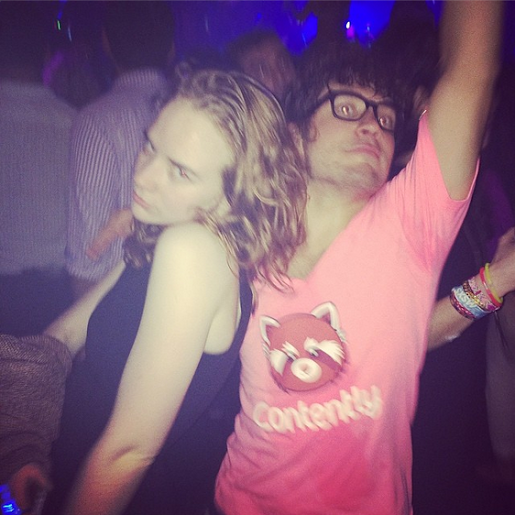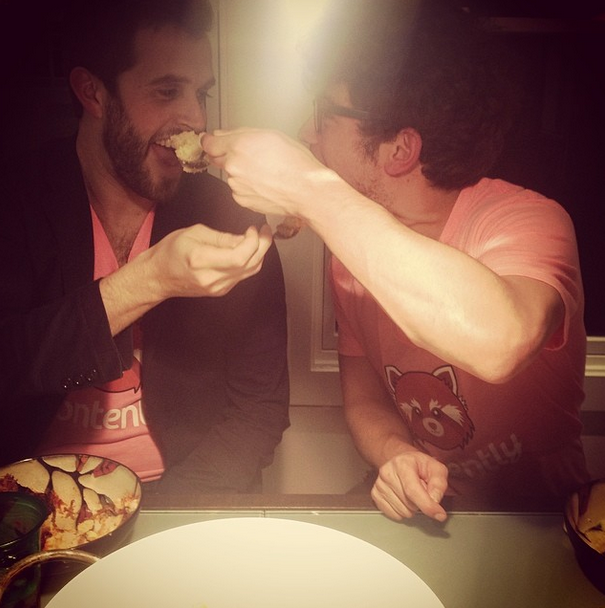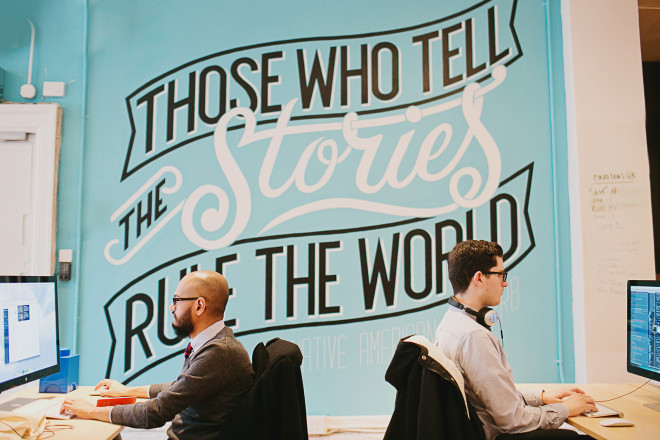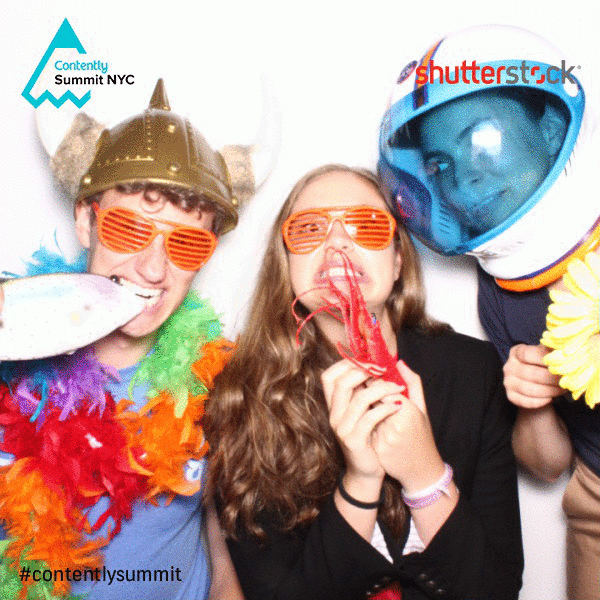Brands
‘You Can’t Do Business Without a Fire Pole’: An Oral History of Contently’s 2014 So Far
There are moments in time that can only be captured through the art form of oral history. Odysseus’ journey home from Troy. Eminem’s Eight Mile. The 2012 Burning Man Festival. The first six months of 2014 at Contently, when a scrappy startup changed the very nature of content, marketing, business, and the game of soccer itself. Enjoy.
By superstar interns Julia Kupper, Jillian Richardson, and Gabe Rosenberg.
I. New waves of hires start to crowd the office.
Joe Coleman (CEO): We’ve added a lot of people—25 people over the last five or six months.
Sanjay Ginde (VP of Engineering): The first six months I was here, we didn’t know if we’d survive. In the last six months, we’ve grown so rapidly.
Corey Cummins (Director of Enterprise Accounts): I started when we were nine people here, so it’s actually really exciting to see it turn into a real company—scary, but also exciting. You never know when you get into a startup if it’s really going to become a growth company. And now we’re hiring all these people and becoming an actual big family.
Shane Snow (CCO): There is that weird feeling you have when you’re working on everything and suddenly other people are doing the things you were working on. As a founder, you become more of a manager than a worker. That embodied the feeling of: “Oh, wow, my job has changed. I’m moving to the Viking table now.”
Jack Combs (Talent Manager): I took over Shane’s desk. It was a very warm seat. Shane has a lot of fire in his belly. Like he-ate-Mexican fire. It still had the imprints, too, from each of his cheeks. We fit nicely against one another.
Joe Lazauskas (Editor-in-Chief): After Jack [Combs], Shane gave me his desk and brand-new HD monitor, and for a moment, I felt like a god. … Then a desk freed up and he took his monitor back and I felt a little sad.
II. Contently raises $9 million of new funding.
Joe Coleman (CEO): We closed our Series B at the beginning of this year, literally the first week of January, so it’s been a pretty clear distinction between this year and last year. We had spent the last year-and-a-half figuring out our company and figuring out what our product is, how we sell it, whom we sell it to, answering all those questions. So this year, it’s more about figuring out: How do you make it as big as you can as quickly as possible without breaking the company?
Shane Snow (CCO): It’s a surreal feeling. You never used to talk in terms of millions of dollars and now you do. The gravity of how much faith that someone has had in you to give you that much money—it’s really cool.
Sam Slaughter (VP of Content): It was a nice relief, because we were operating on a shoestring, improving our business, but still running everything in a budget way. When we raised money, we said: “OK, we can now grow up and be a legitimate company and have a bigger office.” And we were happy, because the press really understood why we were doing it. They understood where our company was going and what we’re about—as opposed to, “This is just some app that is trying to raise cash.” So that was cool.
III. Insights project begins in secret.

Paul Fredrich (VP of Product): Our clients were asking us for help about measuring their content to see how successful their content was, and we looked at a solution that we could offer them, a product that they can use. We realized that all the different products that were designed for different users weren’t for publishers. Then, in late November, we decided to build a product ourselves.
Corey Cummins (Director of Enterprise Accounts): The Insights project is the most exciting thing we’ve done. It’s very original, revolutionary—nobody else is really doing it. I think for a company our size it says a lot about who we are and that we think about stuff like this, even though it’s not our core offering.
Shane Snow (CCO): Insights is one of those things that has and will be a game-changer for the company and the industry. My role in it was to come up with other names besides “Insights”—we thought maybe we can name it something clever like a famous writer, such as Hemingway—and then we ended up calling it “Insights,” anyway.
Joe Lazauskas (Editor-in-Chief): I wanted to call our primary metric “Quality Time,” but apparently that just sounded like an ’80s sitcom.
Corey Cummins (Director of Enterprise Accounts): Instead of using the old-school methods, such as clicks and pageviews, we are trying to evolve the way people look at success.
Joe Lazauskas (Editor-in-Chief): We’ve always believed that pageviews were a pretty terrible primary metric for content success—especially for brands—and once I got placed on the Insights Task Force, I got a little obsessed and wrote about it more and more. E-books, studies, rants, etc. So I guess that was my role—that and stumbling in five minutes late to our Tuesday morning meetings.

Kunal Patel (User Experience Lead): We actually held a launch party [in April]. It was a lot of fun. I ended up doing a last minute demo with Sam for it, which was a little stressful, but it all went well and turned out great. A bunch of prospects showed up, some clients, 60–100 people made it out.
Joe Lazauskas (Editor-in-Chief): The line for fancy cocktails at the Insights party was really long, but luckily John [Hazard, director of client services] ran out and bought a bunch of beer from Duane Reade, and then it got poppin’.
IV. By February, the office starts to get rowdy.

Amanda Weatherhead (Client Services Manager): We were playing a lot of Pitbull all of the time, and I thought it was great because it added a really good party atmosphere to the office. But some of our co-workers didn’t find it so fun to be blasting bumping house music at 9 a.m. on a Tuesday. I think it’s always party time. The weekend is really just a state of mind and I was trying to bring that all the time, but some people did not appreciate it as much as I did.
Sanjay Ginde (VP of Engineering): Some folks were just coming in and thought they could take over the Sonos. I hate to say it, but it was a debate between age-lines. Some of us older folks in our thirties just want to listen to more relaxing music, as opposed to aggressive dance music. We were all crammed into one office pretty tight, and there were some tensions.
Sam Slaughter (VP of Content): Some of us old people were really more into listening to some really pretentious shit.
Elisa Cool (VP of Sales): Somya [Munjal, accountant] had been putting on songs that I’d like to call “songs to slit your wrist to.” And she only worked part-time.
Amanda Weatherhead (Client Services Manager): What really happened was that it became a war. One person would request a J.Lo song and then the next person would put on something completely different. So it was a constant back and forth. It was funny for a while, but then it stopped being funny. I think Kevin [Curtin, developer] hid the Sonos for a while or hid an essential part of it, so no one could use the Sonos and everyone thought it was broken. Then someone sent an email saying that the Sonos was restricted to the people over 30.
Sam Slaughter (VP of Content): In order to make everybody happy, we had to suspend people’s use of the Sonos—you know, growing pains! That’s what happens when you get bigger.
V. The first Contently Quarterly magazine of 2014 is built and designed in just 11 days.
Shane Snow (CCO): The first print magazine [in 2012], we did was in 10 days, but there were only two of us—me and an intern. This one felt much more like a walk in the park because there were more of us to collaborate. You print out the pages, you go over them with a marker, and the cover is always the most frustrating thing that has not been planned until the last second when you need to go to press tomorrow.
Jordan Teicher (Associate Editor): We had a lot of time for the writing and the reporting, and we got the ideas out early enough, and we had space to brainstorm, but for whatever reason it got down to the wire and the design had to be done very quickly.
Joe Lazauskas (Editor-in-Chief): The content and reporting was mapped out for months and mostly finished, but for whatever reason—probably my lack of understanding of how time works—we didn’t loop our print-mag designer Sascha in until there was less than two weeks left. I also kept wanting to make tiny edits, which drove him crazy. But the dude pulled through. It looked great.
Amanda Walgrove (Social Media Editor): They went through a ton of edits, because print is still very sexy and gets priority over online.
Joe Lazauskas (Editor-in-Chief): Probably the most amazing thing was that Shane designed the cover the day before we sent it to print while nursing a 103-degree fever. Personally, I think it helped his creativity.
Shane Snow (CCO): We very quickly went through some ideas and we ended up using that cover as an image of a gun that’s been made into an inkwell with a feather in it. I found the art print, but it was copyrighted. So I emailed the artists asking for permission to use it the day before we were supposed to go to press. Moments before we had to send it, they replied and said it was fine.
Jordan Teicher (Associate Editor): It was rushed, but hopefully in the future, we’ll be able to space it out more. Just finding the right images and making sure that everything was perfect on such a short notice. It was a very hectic process, but somehow we got it all done. I’m not sure how we accomplished it, looking back.
VI. Contently travels to SXSW to release the magazine, host parties, and hobnob.

Corey Cummins (Director of Enterprise Accounts): We met some really intelligent people who understand the market well. You could see how much the industry has evolved, and how people are more and more willing to open up their arms to content marketing.
Joe Lazauskas (Editor-in-Chief): I spent the weekend either handing out our magazine to anyone who would take one—mostly people bored while standing in line to see Lena Dunham speak—or begging my PR friends to help us cut the lines at the big nighttime parties. We saw Run–D.M.C. host a crazy cirque de soleil party, which, in hindsight, really doesn’t make much sense.
Elisa Cool (VP of Sales): My dad played getaway car driver as Joe Lazer, Jess [Black, marketing manager], me, and Ella [Contently writer] had boxes of magazines, and we went and papered the main hotel there. We put our magazines next to The New York Times, we put them in Starbucks, we put them all over the place.
Joe Lazauskas (Editor-in-Chief): The last night of SXSW we threw a low-key party, which was great because I was totally exhausted.
Elisa Cool (VP of Sales): We had a great house from Airbnb and everybody was doing big parties, VIPs, and DJs—so we thought, How can we be different? We realized that our clients are a little bit more sophisticated and they’re not 24-year-old media planners; they’re 30-something VPs of marketing. So we picked a house to be able to host them. We had Mann’s BBQ cater, we had a bartender. It was super chill, hanging out in the backyard of the house.
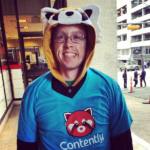 Corey Cummins (Director of Enterprise Accounts): We got to invite about 50–60 people who are clients or potential prospects, and it was really fun to have people come and see how much they love the Contently brand.
Corey Cummins (Director of Enterprise Accounts): We got to invite about 50–60 people who are clients or potential prospects, and it was really fun to have people come and see how much they love the Contently brand.
Elisa Cool (VP of Sales): It was a huge hit, because it was the last night of the event and everyone was really over partying. It was a great way to connect with them. And we paid a poor TaskRabbit a few dollars to wear a PandaMouse costume.
Joe Lazauskas (Editor-in-Chief): The Mann’s BBQ was amazing. There’s a photo of me and Corey [Cummins] feeding each other mashed potatoes after everyone left, which I think really symbolizes how close we are as a company. I mean, sales and content, feeding each other mashed potatoes—where else does that happen?
VI. In April, Contently expands to take over the rest of our floor. One month later, the 5th floor is secured as well.

Brianna Maury (Associate Sales Executive): The day we moved, we created a whole playlist of moving songs and cleaned out the office.
John Hazard (Director of Contently Studios): I wish we got to break down the wall personally. Of the past six months, the biggest bummer was that we didn’t get to take sledgehammers to the east side of the office. Legitimate hired contractors with safety gear and helmets got to do it. We didn’t get to see Joe Lazauskas swinging an axe.
Joe Lazauskas (Editor-in-Chief): It was like our office suddenly became a campus with two sections: the library and the frat house.
Jack Combs (Talent Manager): Every team has been growing. I think we’ll get a few more people on the talent team and then we’ll have enough people to plot against Bill [Loundy, director of talent management] and either get him fired or maybe slash the tire on his bike or something. I dig power. Once I get power, I don’t lose it.
Bill Loundy (Director of Talent): It’s been great to have the extra space, since now I get to sit closer to Jack [Combs].
Brianna Maury (Associate Sales Executive): The sales people are by far the loudest team at Contently, so we’re left to our own devices now, which is good. It’s also sad, though, because I have a lot of friends on the dev side and I don’t really get to talk to them as much. Luckily they come over for the kitchen.
Joe Lopardo (Sales Executive): That also solved the issue of the Sonos, because I feel like once the dev team came to this side, people were still blasting crazy Sonos, but not as many people were complaining—besides Rob [Haber, director of accounts]. It was definitely a relief to have a bit more elbow room, but it was also nice having a small group in one central large room.
Josh Seff (Sales Executive): It definitely changed the dynamic. I liked it when everybody was in one room, because you can annoy everybody and also because everybody was experiencing the same thing. But on the same note, this is a symbol of expansion and growth. When you start to break out these departments and everyone has their own space to accomplish their own initiative, it symbolizes something much larger and you can feel that.

Brianna Maury (Associate Sales Executive): It was also the time when we got new chairs—that was pretty exciting! We had really shitty chairs and now we have Aeron chairs, which are much nicer. Dave [Goldberg, CTO] sent one email and you could see everyone getting the email that the new chairs had arrived and then we all ran. I actually tried to grab one for Corey [Cummins], and Dave said, “No, you’re not allowed to do that! You’re not allowed to sneak chairs for people!” and he got really upset with me.
Joe Coleman (CEO): I think from the people standpoint, we’ll be able to fit between the two spaces about 140 people. Now we have about 50, so we have almost room to nearly triple the company in the current space, which is very unique because not a lot of companies are able to do that—they have to move from location to location. We’ll be here a little while.
Eli Samuel (Operations Manager): They brought me in late last year in the fall when it was just this office space [one half of the office]. There were maybe 20 to 25 employees and in the last six months we’ve doubled the employee population and we’ve tripled our office space size. We now also have the fifth floor, so we might put a fire pole in.
John Hazard (Director of Contently Studios): You can’t do business without a fire pole.
VII. Contently Studios launches.

John Hazard (Director of Contently Studios): The Studios group came together because we were trying to deliver better service for clients, and the only two account managers here were Rob [Haber] and myself, and we were doing our best to just throw things at the clients the best we could. It wasn’t standard; he did things one way, I did things another way. There was no way of ensuring what worked on what client could translate to another client.
Amanda Weatherhead (Client Services Manager): We’re the non-technological product team. We manage all the products that clients can buy outside the platform. We’re also managing editors, strategy, and distribution.
John Hazard (Director of Contently Studios): It’s myself, the director; Amanda, the department manager; and Ryan Galloway manages the editor program. We have the editors showing clients, “Did you see this story in this publication in your field? We need to do stuff like this.”
VIII. The Freelancer launches.

Shane Snow (CCO): So we have two main audiences: brand publishers and freelancers, mostly writers. What we’ve done for freelancers, historically, has been help them get work and help them build a free portfolio, so that they can help themselves get work. We realized that a lot of people were coming to Contently expecting to get jobs from us, and that’s troubling, because we would love to help everyone who needs a job, but can’t. There are more freelancers than there are gigs in our system because we only take on certain clients and we’re not an open marketplace. So we decided that if we couldn’t get them work, we could at least build a publication to help freelancers help themselves.
Wendy Kim (Senior Designer): It was exciting, but also a lot of work at once, because we decided to change the structure of our site really quickly.
Jordan Teicher (Associate Editor): I felt like we had an opportunity to seize the space. There are a ton of freelancers out there, in addition to the 30,000-plus in our network, but nobody had really emerged with a publication that addressed the ins and outs of what it’s like to live the creative hustle.
Sam Slaughter (VP of Content): We saw this opportunity to speak to this constituency that doesn’t really have a unified voice, but comprises an evermore increasing number of people. We thought of it as something that we wanted to read when we were freelancers. The freelance life can be super hard and super alienating and lonely, and it’s nice to feel like you have a publication that is in your corner to talk about the things that matter to you.
Jordan Teicher (Associate Editor): We want The Freelancer to be the community where people talk about tough topics. And we’ve definitely had our fun, too. I think Jillian [Richardson, editorial intern] is single-handedly creating a new blogging genre of stock-photo comedy writing.
Shane Snow (CCO): People are sharing The Freelancer stories like crazy, loads of engagement—I think it’s going to pass The Content Strategist pretty soon in terms of engaged time, and I think that’s partly because there are more freelancers than publishers, so there’s a bigger audience for it and there’s not a publication dedicated to that topic in the way that we’re going after it.

IX. Brett Lofgren comes on board as CRO.
Brett Lofgren (Chief Revenue Officer): I started at the end of May as the chief revenue officer of the company, which was the first C-suite hire that Contently made. As a CRO you’re involved in a lot of different things in the business, from sales to accounts to strategy and talent. Basically, just trying to make sure that the company is organized for success in every division that we have.
Shane Snow (CCO): Yes, it was a big deal! It was the first C-person that we hired, which means that they have a bigger stake in the company than normal and you pay them a lot of money. There’s a lot hanging on getting it right. So bringing in leadership which hasn’t grown up with the company is scary and we interviewed a million people for that job.
Brianna Maury (Associate Sales Executive): He has a ton of experience, which he brings to the team, and he also comes in from a different side because he’s been working in the advertisement world, whereas a lot of us have journalistic backgrounds, even on the sales team.
Sam Slaughter (VP of Content): The reason for hiring Brett was to hire someone that is better at running big companies than we are. We’ve been great in running a small company, but we don’t know anything about having a team of 50. Brett has done this before, he’s a professional, and he’s a grown-up, and he knows exactly what he’s doing, but he’s also really chill.
X. Contently kicks off its company soccer team.
Sam Slaughter (VP of Content): I’m the general manager of the soccer team. But I’m playing, too. Player-coach, I’d say. PLAYER-COACH is my title! [He speaks closely and loudly into the microphone.] PLAYER-COACH! It’s upon me as the coach to make sure that everybody knows what everybody is doing. We’re improving as a team, we’re getting better each week, we’re getting into shape, and we nearly scored on an overhead kick in the last game.
Jack Combs (Talent Manager): Sam shows up shirtless on the field. He has no shirt and no shoes.
Colin Grigsby (Account Director): It hurts, and we’re not very good, but it’s a lot of fun. I like it.
Joe Lazauskas (Editor-in-Chief): Colin showed up to one game, almost headed the ball into our own goal, and then never came again. To be fair, I’m terrible, too. I’ve never played soccer before in my life, so I just run around like a dyslexic puppy.
Bill Loundy (Director of Talent Management): I’m not just on the soccer team, I’m the best player in the soccer team. But really, I have not played soccer since I was eight years old, so I’m very fortunate that the team lets me run around with them and pretend I know what I’m doing.
Jack Combs (Talent Manager): I didn’t play well the last match. I wasn’t happy with my performance. I scored a goal in the first game, so in that regard it’s been alright. Now we have 30 people, and we’re even worse, although we have better players. Honestly, I’m looking at teams to jump ship to. I’m going where my service is appreciated, to take me the furthest. Contently, well, they’re not gonna win it.
Sam Slaughter (VP of Content): I would question anyone who would think of jumping ship, because things are only going to get better. And really the important thing is how good our uniforms look, which is freaking amazing! I would say that the team’s on-field performance is secondary to how good we look.
Bill Loundy (Director of Talent Management): Our jerseys are really fly and with everything we do, we look really good when we’re doing it—that’s 90 percent of it, right?
Jack Combs (Talent Manager): The team doesn’t have what it takes, mainly because of Jordan. He’s selfish, and too tall to play soccer, honestly—he’s a liability out there.
Jordan Teicher (Associate Editor): It’s good to see how unathletic most of the other people are, specifically Jack [Combs]. It’s very cool to compete and to see people outside of work, because other than going to bars I feel like we’re around each other so much, but everyone is always so busy and working hard. So it’s refreshing to do some things separate from the day-to-day life, but still be around people. And the jerseys are awesome. Still not sure why Jack is on the team, though.
Sanjay Ginde (VP of Engineering): I play the goalkeeper in the soccer team. It’s been interesting, because I’m not naturally a goalkeeper. I’ve played a little bit in high school and the last three years, but I’m the only person on the team that owns goalie gloves. It’s been rough as well—I broke a guy’s foot accidentally. I was going after the ball and my legs took off under me and I fell and his leg just got twisted up in there.
Sam Slaughter (VP of Content): It was a legal play. The guy came in challenging the ball, and Sanjay came strong and the other guy came weak. We were sorry to see him break his foot, but he should have known better.
Sanjay Ginde (VP of Engineering): And now everyone on the Contently team is afraid of me.
XI. On June 18, the Contently Summit engulfs the Bowery Hotel.

Shane Snow (CCO): Two weeks before, people were freaking out about how many people have signed up, if everything is put together, if the speakers were confirmed and all that came together at the last second as it always does. At the Summit, you wouldn’t have known that so much work and craziness went into putting it together, because everything went off without a hitch, which was nice.
Joe Lopardo (Sales Executive): The venue at the Bowery Hotel itself was beautiful, the panel was great, all the speakers were great. I was getting great feedback from all the different attendees back there.
Jessica Black (Marketing Manager: Our goal was to have it be very storytelling oriented, which is always our goal. We had awesome discussions around what’s going on in content marketing.
Joe Lazauskas (Editor-in-Chief): Right off the bat, Jeff Jarvis came out swinging. Just eviscerating native advertising like it was nobody’s business. Right off the bat you were like, “This is a no-B.S conference.”
Shane Snow (CCO): My role was to moderate the “metrics panel.” So panels suck, right? People are usually going on for a long time, talking about themselves, and then panels about metrics measurement—it’s hard to be more boring than that. I had a fake gun in my hand and I said, “Pretend I have a gun and I’m putting it to your head, tell me the one thing that matters on this topic!” That became a running joke throughout the panel and it got a lot of laughs. There were a lot of tweets and pictures about me holding a fake gun to the panelists’ heads.

Ali Kriegsman (Sales Strategist): I came from a much bigger company, a much larger team where everything felt really blurry and anonymous. At Contently, we have a lot more authority and thought leaders in the space and I actually know those people, such as Shane. It was definitely the first time that I as a sales person had to be a representative of Contently in a physical way and not just over the phone.
Sam Slaughter (VP of Content): Our conferences are always incredibly fun. Anyone who’s ever been to a marketing conference knows that it can be pretty boring. We’re not just making the content of our panel’s interesting, but also the storytelling around the conference interesting; for example, we had adult ice cream, DJs, and fun shit.
Jessica Black (Marketing Manager): We had a lot of cool vendors, there was a photo booth, and we recruited this street performer who sits in the park and writes poems while you wait.
Joe Lopardo (Sales Executive): Karaoke after the conference was also awesome. I got a little banged up and probably sang 20-too-many songs. Anyway, the more events like that we have, we’ll hopefully do some on the West Coast as well, it puts us in a great place as one of the leaders in the content marketing space.
Joe Lazauskas (Editor-in-Chief): J.Lo was the MVP of karaoke. So much Jersey spirit.
Brett Lofgren (CRO): To see the team wanting to spend time together and wanting to share that moment together, for me, that was just a validation that I picked the right place.
Image by Jacquelyne Pierson
Get better at your job right now.
Read our monthly newsletter to master content marketing. It’s made for marketers, creators, and everyone in between.




